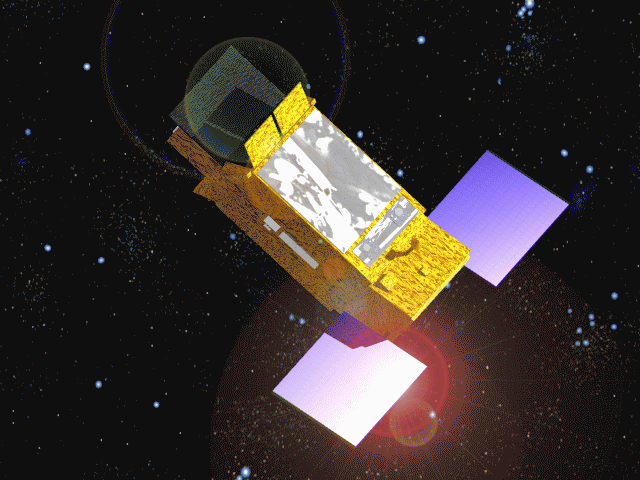

Mission Status Report #46 Star Date: May 16, 2001
Another Milestone for FUSE!
Caption: Artist's concept of FUSE on orbit. (Graphic provided by the Canadian Space Agency. See FUSE Graphics page for more information.)
Hello World, All continues to go extremely well on the FUSE project, with the satellite hardware behaving nominally, and ground operations at JHU going smoothly. June 1 will mark the official mid-point of the FUSE primary science mission, with 1-1//2 years of science operations completed at that point. We have continued to streamline our operations and our planning tools and have managed to squeeze out even better "science efficiency" than we have had previously. Over the last month, our average weekly science efficiency numbers have been over 30%. ("Science efficiency" is time spent actually observing science targets compared to wall clock time.) We averaged about 27% over the first year, so this is a significant increase (about 10% more data per unit time). This is an excellent efficiency for a satellite in low earth orbit, such as FUSE. Speaking of orbits, FUSE approaches another milestone of sorts this week. On Thursday evening May 17, FUSE will accomplish its 10,000th orbit around the earth! FUSE orbits about 760 km (475 miles) above the earth, and takes about 100 minutes to go around once. With a little math, this means FUSE travels about 7.5 km per second (4.7 miles per second) to stay in orbit, and has travelled some 450 million kilometers (280 million miles) since its launch on June 24, 1999. While this sounds like a lot (and it is!), it has all been spent circling the earth. We are "going no where fast", so to speak, compared to missions like the Voyager spacecraft, whose mission was to fly out past the planets and beyond. As of the last report, Voyager I was the most distant manmade object, at a distance of some 12 billion kilometers, and still travelling away from earth at some 17 kilometers per second! While we can communicate with FUSE almost instantaneously (when it is in view of our ground station), it takes radio signals (moving at the speed of light) more than 22 hours to make the round trip to Voyager I and back! On another front the request phase for Cycle 3 observations just concluded on May 11, 2001. Over the next several months, NASA will go through the process of assessing these proposals and choose a set of Guest Investigator observations for the observing year beginning this December. Thanks to all who proposed, and good luck! (See the FUSE Guest Investigator page [no longer in existence] for further information.)
Reported by: Bill Blair, Chief of Observatory Operations
|
